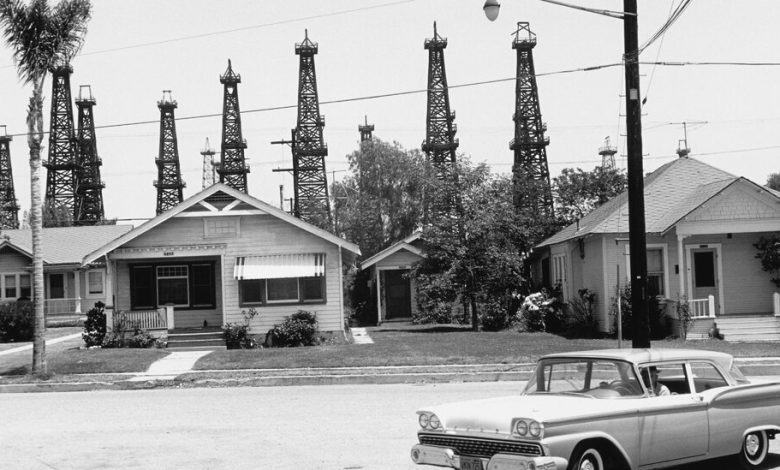From the Lens of Lee Friedlander, Real Estate Focusing on the Real

These days, real estate imagery is often defined by staged hotel-lobby-style furniture and generic artwork, dramatic drone shots on unsettlingly perfect sunny days and a lack of human presence — almost never do you see any people or evidence that these homes have been lived in.
Lee Friedlander’s new photo book, “Real Estate,” published by Eakins Press Foundation, runs counter to all that. Spanning over 60 years of work with 155 photos, the collection takes viewers on journeys from Alaska to Arizona to New York and more, often viewed from the driver’s seat of Mr. Friedlander’s car. There are images of houses and apartments, sure, but there are also images of life and death, construction and destruction. One image shows a billboard advertising, “We buy ugly houses.” The collection is a much-needed reminder that everyday-ness, ugliness and the world as it is — without any manicuring or staging — is worth admiring.
“In a Friedlander picture, the houses have personalities. The buildings look like they’ve been caught in the act of doing something embarrassing,” wrote Peter Kayafas, the director of Eakins Press Foundation, in the afterword. As opposed to much other real estate photography, which is “fraught with layers of subjectivity passed off as impartiality: think of the fisheye lens that stretches the space of an otherwise punishingly cramped NYC apartment,” Mr. Kayafas wrote.
Throughout his career, Mr. Friedlander has made around 70 photo books and became known for capturing what many curators, artists and writers would refer to as the American “social landscape” through everyday people, places and things, traversing urban, suburban and rural environments. “If the world was made of ice cream, I have a spoon,” said Mr. Friedlander, 89.
In response to questions sent by email, Mr. Friedlander responded in a voice recording and reflected on his photography and American real estate. This interview has been edited and condensed.
Today, images made for social media or on real estate listing websites are often clinically and unrealistically perfect. But with your work, I loved seeing the overgrown trees, the unkempt lawns, the shadows, the crooked decorations. You see places as they are inhabited. How has the idea of capturing this kind of rawness informed your work? What does it mean to you?
I’m a garbage collector. The more stuff in the picture, the better. Wouldn’t you say so? In a sense, it’s more fun to add more stuff if you can, and still make the picture. Second of all, in terms of what I’m doing, I mean, I’m not selling these houses. I’m just walking by them. So I’m kind of interested in what’s going on besides the house itself. Maybe I’m not even interested in real estate. Maybe it’s the perfect garbage can for the moment.
Throughout the book, fences are among a few of the objects that you see over and over again. How do you view fences in conjunction with real estate, and how do you think they shape space?
I love chain-link. They’re just there. They cover half the picture, each one. The difference between the chain-link and the other fences, you know, is you can see through the chain-link. So you’re not discouraging what’s beyond it.
You see this idea of architectural sameness in many of the photos, where entire streets or developments of homes all look alike, sometimes startlingly so. What do you make of this?
They’re not very inventive. If you look at things being built, some guy buys a big piece of land, and he puts the same house on it 14 times. He didn’t have to hire another architect.
Looking back at these photographs, what aspects of the American landscape do you feel have stayed the same over time? What’s notably different?
I’m not smart enough to answer that.
Walk me through a few of the photographs. What’s the story behind this image?
I was driving along, and they were burning down the house. It was urban renewal. So they gave them the house to burn down, and then they all stood in front of it. You know, I’m a photographer for Christ’s sakes.
What do you remember about this one?
I spent a 100th of a second there. The camera knew.
Were you driving when you took this photo?
Oh, yeah. I don’t even know where it is. We had a friend who actually did that — he bought a lot, he bought a house, they drove it in. And two days later, it was livable.
Can you tell me about the very last photo in the book?
That’s my mother-in-law’s underwear. She lived in Fort Lee. It’s also funny.
Is there a photograph you wish you took, but didn’t, that still haunts you? Can you tell me about that moment? (At this point, Maria Friedlander, Mr. Friedlander’s wife interjected, “What about some of the license plate ones?”)
Oh, “QTPIE,” yes. I followed her. ’Cause she was great. It was Las Vegas, and her license plate was “QTPIE,” and she made a red light that I couldn’t. I was gonna get killed. I was gonna follow her till she stopped and then photograph her and the car. She got away.
